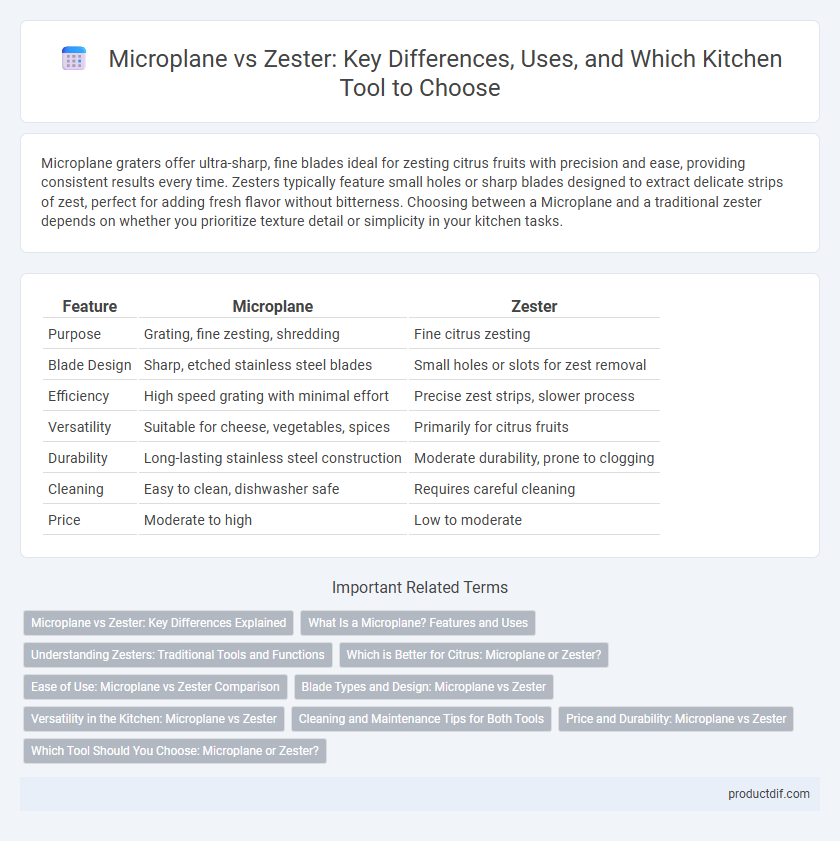Microplane graters offer ultra-sharp, fine blades ideal for zesting citrus fruits with precision and ease, providing consistent results every time. Zesters typically feature small holes or sharp blades designed to extract delicate strips of zest, perfect for adding fresh flavor without bitterness. Choosing between a Microplane and a traditional zester depends on whether you prioritize texture detail or simplicity in your kitchen tasks.
Table of Comparison
| Feature | Microplane | Zester |
|---|---|---|
| Purpose | Grating, fine zesting, shredding | Fine citrus zesting |
| Blade Design | Sharp, etched stainless steel blades | Small holes or slots for zest removal |
| Efficiency | High speed grating with minimal effort | Precise zest strips, slower process |
| Versatility | Suitable for cheese, vegetables, spices | Primarily for citrus fruits |
| Durability | Long-lasting stainless steel construction | Moderate durability, prone to clogging |
| Cleaning | Easy to clean, dishwasher safe | Requires careful cleaning |
| Price | Moderate to high | Low to moderate |
Microplane vs Zester: Key Differences Explained
Microplane graters feature ultra-sharp, etched stainless steel blades designed for effortless zesting and fine grating, offering superior precision and durability compared to traditional zesters with individual holes. Unlike zesters that create thicker, coarser strands, Microplanes produce finely grated citrus zest and hard cheeses, enhancing texture and flavor in recipes. The ergonomic handle and larger surface area of Microplanes improve ease of use and efficiency, making them a preferred tool for professional chefs and home cooks alike.
What Is a Microplane? Features and Uses
A Microplane is a finely etched stainless steel grater renowned for its sharp, precise blades that effortlessly zest citrus fruits, grate hard cheeses, and spice up dishes with fresh nutmeg or ginger. Its ergonomic handle and razor-sharp blades make it a versatile kitchen tool, preferred for speed and efficiency in producing fine, fluffy zest without the bitter white pith. Widely used by professional chefs and home cooks, the Microplane is essential for enhancing flavor and texture in recipes requiring delicate grating or zesting.
Understanding Zesters: Traditional Tools and Functions
Traditional zesters feature a series of small, sharp holes designed to finely grate citrus peel without reaching the bitter pith, making them ideal for adding fresh zest to dishes and drinks. Unlike Microplane graters, zesters are generally simpler tools with less surface area, focusing on precision rather than volume. Their function centers on delicately extracting the flavorful outer layer of fruits like lemons, limes, and oranges for culinary use.
Which is Better for Citrus: Microplane or Zester?
A Microplane is generally better for zesting citrus due to its fine, sharp stainless steel blades that efficiently create delicate, fluffy zest without removing bitter pith. In contrast, traditional zesters have larger holes and a less sharp edge, producing thicker strips that may be less ideal for recipes requiring finely grated citrus peel. For culinary precision and maximizing flavor, the Microplane is preferred for zesting lemons, limes, and oranges.
Ease of Use: Microplane vs Zester Comparison
The Microplane grater offers superior ease of use with its ergonomic handle and sharp, stainless steel blades that require minimal effort for zesting or grating. In contrast, traditional zesters often demand more wrist strength and precise motion, making them less comfortable for prolonged use. Users frequently prefer Microplanes for their efficient design, reducing hand fatigue and ensuring consistent results in zesting tasks.
Blade Types and Design: Microplane vs Zester
Microplane graters feature sharp, etched stainless steel blades designed with tiny, raised teeth that efficiently shred citrus zest, hard cheeses, and spices with minimal effort. Traditional zesters typically have a single or multiple semi-circular sharp-edged holes that channel fine strips of citrus peel but can struggle with harder ingredients. Microplane's elongated, flat design offers greater surface area and ergonomic control, while classic zesters are simpler with a smaller, handheld build for precision zesting.
Versatility in the Kitchen: Microplane vs Zester
Microplane graters offer superior versatility in the kitchen, efficiently handling tasks from zesting citrus fruits to grating hard cheeses and spices like nutmeg. Zesters, typically designed with larger holes, excel at producing long, elegant strips of citrus peel but are less effective for fine grating or shredding tasks. Choosing a Microplane ensures a multifunctional tool capable of precise, varied shredding and zesting, making it essential for diverse culinary applications.
Cleaning and Maintenance Tips for Both Tools
Microplane graters and traditional zesters require careful cleaning to maintain sharpness and hygiene; rinse immediately after use to prevent food residue from drying and clogging the fine teeth. Use a soft brush or toothbrush to remove particles lodged in the blades, avoiding abrasive cleaning pads that can dull the cutting edges. Both tools benefit from hand washing with warm, soapy water and thorough drying to prevent rust and prolong their lifespan.
Price and Durability: Microplane vs Zester
Microplane graters generally offer superior durability due to their stainless steel construction, making them a long-lasting kitchen tool compared to traditional zesters that may feature softer metals prone to wear. In terms of price, Microplanes typically fall in the mid to high range, reflecting their premium build and efficient design, whereas basic zesters are often more affordable but may lack durability. Investing in a Microplane can provide better value over time thanks to its robust performance and resistance to dulling.
Which Tool Should You Choose: Microplane or Zester?
Microplane graters feature ultra-sharp, stainless steel blades ideal for finely grating hard cheeses, citrus zest, garlic, and spices, providing a versatile and efficient kitchen tool. Zesters, typically equipped with small, sharp holes, excel at extracting thin strips of citrus peel without the bitter pith, perfect for delicate garnishes and cocktails. Choose a Microplane for multifaceted grating needs and finer textures, while a zester is best for precise citrus zesting and presenting visually appealing garnishes.
Microplane vs Zester Infographic

 productdif.com
productdif.com